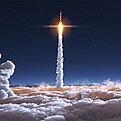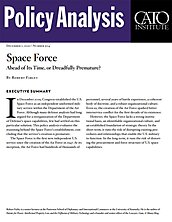1. Eric Gomez, “Space Force: An Unwise Solution to an Overhyped Threat,” Orlando Sentinel, August 28, 2018.
2. U.S. Space Force, Spacepower: Doctrine for Space Forces (Colorado Springs: Headquarters, U.S. Space Force, June 2020), pp. 3–4.
3. U.S. Space Force, Spacepower, p. 10; and Paul Voosen, “Outer Space May Have Just Gotten a Bit Closer,” Science, July 24, 2018.
4. David N. Spires, Beyond Horizons: A Half Century of Air Force Space Leadership (Colorado Springs: Air Force Space Command in association with Air University Press, 1998), p. 7.
5. Douglas M. O’Reagan, Taking Nazi Technology: Allied Exploitation of German Science after the Second World War (Baltimore: Johns Hopkins University Press, 2019), p. 249.
6. Spires, Beyond Horizons, p. 94, 140.
7. Todd Harrison, “The Risks a War in Space Poses for Nuclear Stability on Earth,” in America’s Nuclear Crossroads: A Forward-Looking Anthology, eds. Caroline Dorminey and Eric Gomez (Washington: Cato Institute, July 2019), pp. 29–36.
8. Justin Paul George, “History of Anti-Satellite Weapons: US Tested 1st ASAT Missile 60 Years Ago,” The Week, March 27, 2019.
9. Spires, Beyond Horizons, pp. 244–5.
10. Richard Baldwin, The Great Convergence: Information Technology and the New Globalization (Cambridge, MA: Harvard University Press, 2016), p. 4.
11. James M. Acton, “Escalation through Entanglement: How the Vulnerability of Command-and-Control Systems Raises the Risks of an Inadvertent Nuclear War,” International Security 43, no. 1 (Summer 2018): 56–99; Michael P. Gleason and Luc H. Riesbeck, Noninterference with National Technical Means: The Status Quo Will Not Survive (El Segundo: Aerospace Corporation, 2020), p. 2; and Harrison, “Risks a War in Space,” p. 34.
12. Gregory Kulacki and Jeffrey G. Lewis, “Understanding China’s Antisatellite Test,” Nonproliferation Review 15, no. 2 (2008): 335–47.
13. Brian Weeden, “The Space Security Implications of Missile Defense,” Space Review, September 28, 2009.
14. Ashley J. Tellis, “India’s ASAT Test: An Incomplete Success,” Carnegie Endowment for International Peace, April 15, 2019.
15. Spires, Beyond Horizons, pp. 18, 25, 44, and 51–53.
16. Spires, Beyond Horizons, p. 87.
17. Edward J. Drea et al., History of the Unified Command Plan: 1946–2012 (Washington: Joint History Office, Office of the Chairman of the Joint Chiefs of Staff, 2013), pp. 25 and 32.
18. Spires, Beyond Horizons, pp. 176, 179, 182, 197, and 207.
19. Historical Office, A Chronological Review of 60 Years (Huntsville, AL: U.S. Army Space and Missile Defense Command/Army Forces Strategic Command, 2018).
20. Drea et al., History of the Unified Command Plan, pp. 55 and 56.
21. Todd Harrison, “Is Congress Creating a Military Space Corps?,” Center for Strategic and International Studies, November 8, 2017.
22. FY18 National Defense Authorization Bill, H.R. 2810, 115th Cong. (June 22, 2017), https://docs.house.gov/meetings/AS/AS29/20170622/106134/BILLS-115HR2810ih.pdf; and Kaitlyn Johnson, “Space Force or Space Corps? Competing Visions for a New Military Service,” Center for Strategic and International Studies, June 27, 2019.
23. Donald J. Trump, “Text of a Memorandum from the President to the Secretary of Defense Regarding the Establishment of the United States Space Command,” White House, December 18, 2018.
24. ABC15 Arizona, “‘The SPACE FORCE! Very serious!’ President Trump at Rally,” October 19, 2018, YouTube video, 1:09.
25. Aaron Mehta, “Space Command to Launch Aug. 29,” Defense News, August 20, 2019.
26. W. T. Johnsen, “Theory of War and Strategy Directive,” in U.S. Army War College Academic Year 2019 Core Curriculum (Carlisle, PA: U.S. Army War College, 2018).
27. Robert M. Farley, Grounded: The Case for Abolishing the United States Air Force (Lexington: University Press of Kentucky, 2014).
28. John J. Klein, “Corbett in Orbit: A Maritime Model for Strategic Space Theory,” Naval War College Review 57, no. 1 (Winter 2004): 59; and James W. E. Smith, “Corbett Offers More on Space Than Mitchell,” War on the Rocks, December 11, 2019.
29. Eric Sterner, “Beyond the Stalemate in the Space Commons,” in Contested Commons: The Future of American Power in a Multipolar World, eds. Abraham M. Denmark and James Mulvenon (Washington: Center for a New American Security, January 2010), pp. 105–36.
30. Peter Garretson, “A Historic National Vision for Spacepower,” War on the Rocks, September 9, 2019.
31. Air Force Space Command, The Future of Space 2060 and Implications for U.S. Strategy: Report on the Space Futures Workshop (Colorado Springs: Air Force Space Command, September 5, 2019).
32. U.S. Space Force, Spacepower, p. 28.
33. See, for example, Bleddyn E. Bowen, War in Space: Strategy, Spacepower, Geopolitics (Edinburgh, UK: Edinburg University Press, 2020); Joan Johnson-Freese, Space Warfare in the 21st Century: Arming the Heavens (London: Routledge, 2016); and John C. Wright, Deep Space Warfare: Military Strategy Beyond Orbit (Jefferson, NC: McFarland & Company, 2019).
34. “United States Space Force Mission,” U.S. Space Force, https://www.spaceforce.mil/About-Us/About-Space-Force/Mission/.
35. Office of the Under Secretary of Defense (Comptroller)/Chief Financial Officer, Defense Budget Overview: Irreversible Implementation of the National Defense Strategy (Washington: U.S. Department of Defense, May 13, 2020), p. 5-2.
36. Sandra Erwin, “Acquisition in State of Confusion: Questions Loom on the Role of the Space Development Agency,” SpaceNews, March 6, 2020.
37. Sandra Erwin, “Air Force Says Space Development Agency Should Be in the Space Force Now, Not Later,” SpaceNews, May 19, 2020.
38. Peter R. Mansoor and Williamson Murray, eds., The Culture of Military Organizations (Cambridge, UK: Cambridge University Press, 2019), p. 2.
39. Leonard Wong and Stephen J. Gerras, “Culture and Military Organizations,” in The Culture of Military Organizations, p. 19.
40. Perry McCoy Smith, The Air Force Plans for Peace, 1943–1945 (Baltimore: Johns Hopkins University Press, 1970).
41. Robert Farley, “U.S. Air Force Culture, 1947–2017,” in The Culture of Military Organizations, pp. 428 and 430.
42. Sandra Erwin, “Survey: Most Army Space Officers Would Transfer to the U.S. Space Force,” SpaceNews, April 28, 2020.
43. Oriana Pawlyk, “Major Space Force Units to Be Called Deltas, Officials Announce,” Military.com, June 30, 2020.
44. Joseph Trevithick, “Here Are the Names Space Force Rejected in Favor of Calling Its New Units ‘Deltas,’” War Zone, July 8, 2020.
45. Tami Davis Biddle, Rhetoric and Reality in Air Warfare: The Evolution of British and American Ideas about Strategic Bombing, 1914–1945 (Princeton, NJ: Princeton University Press, 2009); and Stephen Peter Rosen, Winning the Next War: Innovation and the Modern Military (Ithaca, NY: Cornell University Press, 1994).
46. Allan R. Millett, Williamson Murray, and Kenneth H. Watman, “The Effectiveness of Military Organizations,” International Security 11, no. 1 (July 1986): 37–71.
47. Brian A. Hill, “Assessing ISR: Effectively Measuring Effectiveness,” Air & Space Power Journal 31, no. 3 (Fall 2017): 34–43.
48. Gian Peri Gentile, “Advocacy or Assessment? The United States Strategic Bombing Survey of Germany and Japan,” Pacific Historical Review 66, no. 1 (1997): 53–79.
49. Philip Caruso, “A Space Force & Experiences with Airpower and the Great War,” Lawfare, September 7, 2018.
50. Herman S. Wolk, Reflections on Air Force Independence (Washington: Air Force History and Museums Program, 2007), p. 77.
51. Farley, Grounded, pp. 40–41.
52. Caitlin M. Kenney, “Marines See Funding Dip, Personnel Reductions in $46 Billion in Budget Request for 2021,” Stars and Stripes, February 10, 2020.
53. Jason Coleman, Adam Talaber, and F. Matthew Woodward, The Personnel Requirements and Costs of New Military Space Organizations (Washington: Congressional Budget Office, May 2019).
54. Sandra Erwin, “Wilson: $13 Billion Space Force Cost Estimate Is ‘Conservative,’” SpaceNews, September 18, 2018.
55. Erin Duffin, “Budget of the U.S. Navy and the U.S. Marine Corps from Fiscal Year 2001 to 2021,” Statista, March 9, 2020.
56. For a breakdown of the evidence, see Mackenzie Eaglen, “Is Army Richest Service? Navy? Air Force? AEI’s Eaglen Peels Back Budget Onion,” Breaking Defense, February 5, 2020.
57. U.S. Space Force, Spacepower.
58. Michael Klesius, “Sick in Space: It’s Not Just a Problem for Astronauts Anymore,” Air & Space Magazine, March 8, 2009, https://www.airspacemag.com/space/sick-in-space-56746153/?no-ist.
59. Wendy Whitman Cobb, “Would a Space Force Mean the End of NASA?,” The Conversation, October 18, 2018.
60. Clifford M. Theony, “Infrastructure Readiness in the United States Space Force,” OTH: Over the Horizon, April 20, 2020.
61. “Adjutants General Advocate for Space National Guard,” National Guard Association of the United States, February 18, 2020; and Brent D. Ziarnick, “An Aggressive Space Force Begins with a Space Force Reserve,” The Hill, May 1, 2020.
62. Andrew Diederich and Jacqueline E. Whitt, “What Should a U.S. Space Force Look Like?,” War Room, July 23, 2019.
63. Rajeswari Pillai Rajagopalan, “It Is Time for Space Governance Talks,” The Diplomat, May 21, 2020.
64. For discussion, see Jen Patja Howell, “The Lawfare Podcast: The SpaceX Launch and the Future of Space Law,” Lawfare, May 26, 2020; and United Nations Office for Outer Space Affairs, “Treaty on Principles Governing the Activities of States in the Exploration and Use of Outer Space, including the Moon and Other Celestial Bodies,” https://www.unoosa.org/oosa/en/ourwork/spacelaw/treaties/introouterspacetreaty.html.
65. Marko G. Markoff, “Disarmament and ‘Peaceful Purposes’ Provisions in the 1967 Outer Space Treaty,” Journal of Space Law 4, no. 1 (Spring 1976): 3–22.
66. Peter Gray, The Leadership, Direction and Legitimacy of the RAF Bomber Offensive from Inception to 1945 (London: Bloomsbury Publishing, 2012), p. 54.
67. Richard W. Fanning, Peace and Disarmament: Naval Rivalry and Arms Control 1922–1933 (Lexington: University Press of Kentucky, 1995), p. 8.
68. Michael O. Wheeler, “The United States Air Force and Arms Control: The Early Years,” in Milestones in Strategic Arms Control, 1945–2000: United States Air Force Roles and Outcomes, eds. James M. Smith and Gwendolyn Hall (Colorado Springs: U.S. Air Force Academy, 2002), pp. 6 and 20.
69. Edward Kaplan, “Peace through Strength Alone: U.S. Air Force Views on Arms Control in the 1950s and Early 1960s,” in Milestones in Strategic Arms Control, p. 28.
70. Jeffrey A. Larsen, “Strategic Arms Control and the U.S. Air Force: The SALT Era, 1969–80,” in Milestones in Strategic Arms Control, pp. 101 and 102–104.
71. Forrest E. Waller Jr., “National Security Strategy, Arms Control, and the US Air Force: The Reagan Years, 1981–88,” in Milestones in Strategic Arms Control, p. 183.
72. Sean Gallagher, “Polls Show Little Support for Trump’s Space Force,” Ars Technica, August 16, 2018.


